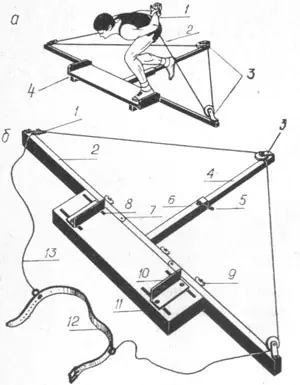But I wonder: are there any training devices for modern speed skaters? Or is it their eternal destiny to hone their skills while standing on natural or artificial ice? Perhaps there is some special simulator for speed skaters that helps improve their technique and develop the necessary muscle groups? As you understand, of course, there is such a simulator! And not alone!
Modern speed skating is a sport of persistent and patient people, because it takes years to develop the correct champion movement technique. Moreover, the training of speed skaters is not at all limited to work on the ice. For this sport, as for most other sports disciplines, all kinds of training devices, instruments and devices are successfully used. In the next two articles on our sports website we will review and study them...
So, what else besides skates and ice do modern speed skaters have in their arsenal?
A block device is a simulator for speed skaters.
This training device is more complicated compared to the classic block device from a typical gym. It helps to control the implementation of the leading elements of the skaters' movement technique within the given parameters and trajectories of movement. Exercises on a training device help improve the strength and speed-strength training of athletes.
The device under consideration (Fig. 1, a) consists of a fixed platform 4 measuring 30 x 150 cm, covered with a material that ensures the best sliding; three roller blocks 3, a belt 1 and a flexible connection 2 passing through the rollers. The seat height can be adjusted using the rear roller. By moving it aside or bringing it closer, you can change the tension of the flexible connection (for this it is best to use a nylon halyard). Roller blocks can be mounted in the gym, as well as directly on the sports field. To do this, use metal pins driven into the ground.
The general view of the simulator is shown in Fig. 1, a, top view of the simulator platform - in Fig. 1, b.
Roller skates in speed skating training.
The volume of workload in roller skating has increased several times in recent years for many skaters, not only in training the strongest, but also in training beginner athletes.
To understand the specifics of the next device we are considering, first read: How to choose the right roller skates. Having figured out how typical walking rollers for the mass consumer are structured, let’s move on to considering a specialized option for athletes...
The authors have made some changes to the design of roller skates produced by the domestic industry.
The vertical axes of all rollers are on a single horizontal line (see Fig. 2, a). The introduction of a fifth roller skating rink made it possible to change the distance between the axes of the holes of all skating rinks and add another hole in the middle of the skating rink. Thus, the distance between the axes of all rollers became equal to 70 mm (Fig. 2, b).
Changing the horizontal distance between the axes of the holes for the roller skate rollers led to a different arrangement of the axes of the holes vertically (Fig. 2, c). The first and fifth holes are located on the same vertical horizontal axis, as in a commercially produced skate. The second and fourth holes are located on another horizontal axis 2 mm below the axes of the first and fifth holes. The third hole is located on the third horizontal axis 2 mm below the axes of the second and fourth holes.
Post Views: 163


